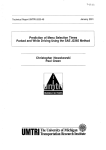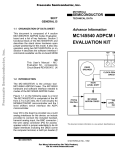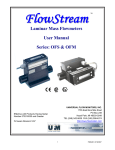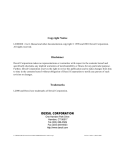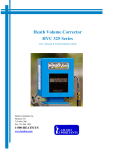Download View User Manual PDF
Transcript
SURE-LOCK Distance Pro ® User Manual Proprietary Notice The contents of this manual are proprietary to Heath Consultants Incorporated. Reproduction of this manual, in whole or in part, is prohibited without the express written consent of Heath Consultants Incorporated. Heath Consultants Incorporated operates under a continual product improvement program and reserves the right to make improvements and/or changes without This manual supersedes all previous manuals for the Heath Sure-Lock Distance Pro. HPN 1016003, Revision D ©COPYRIGHT 2012, Heath Consultants Incorporated SURE-LOCK® Distance Pro User Manual Heath Consultants Incorporated Houston, TX 713-844-1300 Fax: 713-844-1309 1-800-HEATH-US www.heathus.com Heath....Safety, Leadership, Innovation, Performance Then, Now and Tomorrow FUNCTION The Sure-Lock® Distance-Pro is a state-of-the-art, 8.1KHz cable and pipe locator system designed to provide the operator the capability to accurately and output make it especially effective for tracing a variety of conductors and for those Virtually all buried utilities capable of signal conduction can be more accurately and continuous, trouble-free operation for many years. 1 TaBLe OF CONTeNTS Function ........................................................................... 1 CHaPTeR I - GeNeRaL DeSCRIPTION Description of System Components ....................................................... 4 Transmitter ....................................................................... 4 Receiver ............................................................................... 4 Cable/Grounding Kit ........................................................ 4 Instruction Manual .................................................. 4 Carrying Case ............................................................ 4 Coupler Clamp (Optional) ....................................................... 5 Sure-Lock Distance Pro Configuration ........................................... 5 Figure 1-1 (System Components) ....................................................... 6 Sure-Lock Transmitter ................................................................ 7 Specifications ................................................................... 7 Controls ...................................................................... 8 Figure 1-2 (Transmitter) ......................................................................... 9 Figure 1-3 (Transmitter Side Panel Output Connector) ............................. 9 Sure-Lock Receiver ..................................................................... 10 Specifications .................................................................... 10 Figure 1-4 (Receiver) ............................................................... 11 Controls .......................................................................... 12 Additional Connector ................................................................. 14 Figure 1-5 (Receiver - Additional Connector) ....................................... 14 CHaPTeR II - GeNeRaL OPeRaTING PROCeDUReS Operating Procedures ................................................................. 15 Transmitter .................................................................... 15 Transmitter - Inductive Mode .................................................... 16 Figure 2-1 (Transmitter Alignment) ............................................... 17 Figure 2-2 (Transmitter Alignment) ................................................... 18 Figure 2-3 (Transmitter Alignment) .................................................. 19 Conductive (Direct Connect) Mode ............................................... Figure 2-6 (Correct and Incorrect Grounding Application) ................ Using the Coupler Clamp ..................................................... Figure 2-7 (Coupler Clamp Connection) ........................................ Figure 2-8 (Coupler Clamp Connection) ........................................ Figure 2-9 (Coupler Clamp Connection) ........................................ Using the Receiver ............................................................... 2 21 22 23 25 26 26 26 Figure 2-10 .................................................................... 28 Conductor Depth Procedure ...................................................... 29 CHaPTeR III - MaINTeNaNCe Battery Charging And Replacement Instructions ........................................... 31 Transmitter ................................................................. 31 Receiver ........................................................................ 31 Routine Maintenance of the Sure-Lock .................................................. 32 Optional Accessories ....................................................................... 33 Warranty and Warranty Repairs ........................................................... 34 Repair Authorization ............................................................... 35 Customer Assistance and Service Locations ....................................... 36 3 CHaPTeR I GeNeRaL DeSCRIPTION DeSCRIPTION OF SYSTeM COMPONeNTS (See Figure 1-1) Transmitter self-monitoring features and includes a sealed, rechargeable battery to support The top panel of the transmitter is constructed of a corrosion-resistant aluminum alloy. Also included is a 120 VAC plug-in battery charger for fully automatic charging of the transmitter battery from any discharged condition. Receiver The receiver also combines numerous automatic performance and self monitoring features, all microcomputer based. These features include automatic gain control, continuous estimated and calculated depth display, operator guidance, housing is ergonomically balanced and constructed of ABS plastic for strength ceiver. The receiver is fully sealed against rain and dust. Cable/Grounding Kit 1. 2. 3. 4. “L” Shaped grounding spike Aluminum grounding plate Conductive cable assembly Bridging Cable (With Clamp only) Instruction Manual tion. Carrying Case The molded and padded interior provides protection from moisture, shock, and vibration. **NOTE** THE SURE-LOCK SHOULD BE KEPT IN ITS CARRYING CASE WHEN NOT IN USE. 4 Coupler Clamp (Optional) Model 91 HPN 58212524 When it can be used, the coupler clamp is a very accurate means for tracing and ing conductors. signal compared to conventional methods of energizing the trace conductor. The coupler clamp is also the most effective method of isolating a conductor from interfering conductors in the area of the search. It CANNOT be used on all tracing the signal must be able to travel in both directions on the conductor. If the trace point of attachment, the coupler clamp may not function. This “break” in the 8.1 Transmitter Clamps(s) Charger 91 SURe-LOCK Frequency Selection Guide 8.1 K Model 91 - Electric and communication distribution cables - Transmission gas facilities - Fiber optic communication cables 50-60 5 D A B C F H E G Figure 1-1 (Sure-Lock System Components) A. Transmitter E. Grounding Plate B. Receiver F. Coupler Clamp 4” ID (Optional) C. Case G. Grounding Spike D. Manual D. Wall-Mount Charger 6 SURe-LOCK TRaNSMITTeR (Figure 1-2) 1. 2. 3. - 4. Loads from 5 ohms to 10 K ohms. 5. 6. 7. 8. 9. 10. 11. 12. O F to 150OF (-32OC to 65OC). 13. D), typical. 14. 15. NEMA 3S and IP 54. The housing is also shock and vibration resistant. 16. to earth ground to prevent electrical shock. ylene carrying case. 7 Controls and battery charge level. housing for operator safety. acid battery. 8.1K output to the target conductor. parallel to the target conductor 8 A H G F E B C D Figure 1-2 (Transmitter) A. LCD Display E. Safety Ground Jack A B C Figure 1-3 (Transmitter Side Panel Output Connector) A. Safety Ground Jack B. Battery Charging Jack 9 WaRNING! SaFeTY FIRST! Check for and turn off all power sources before connecting the transmitter directly to otherwise power carrying cables. Direct connection must NOT be to live 50/60 hertz power sources up to 240 VaC!! The power must be OFF!! Be certain the transmitter POWeR is off before handling the clips on the conductive assembly. The transmitter can deliver over 100 volts of signal which is capable of producing electrical shock if not carefully handled. SURe-LOCK ReCeIVeR (Figure 1-4) 1. 2. 3. 4. (estimated depth). Metric units (cm) selectable per order. Automated “calculated depth” function. 5. 6. 7. 8. 9. 10. 11. 12. 13. 14. degrees Fahrenheit (-32 degrees Celsius to 65 degrees Celsius). 15. cm D), typical. 16. 17. and IP 54 standards. 18. 10 A I B C H D G E F Figure 1-4 (Receiver) B. Left-Right Indicator C. Battery Status Indicator D. Lock Indicator F. Bubble Level H. Estimated/Calculated Depth Indicator I. Volume Level Indicator 11 Controls operator must become familiar (Figure 1-4). 1. the location and depth of the conductor being traced. A variety of information is displayed. a. 1. 2. A normal (active) tracing mode signal using the transmitter. conductor. The transmitter is not used in this mode. to the intended conductor, the numbers increase and as the operadecrease. **NOTE** THESE SPI NUMBERS ARE RELATIVE AND DO NOT BEAR ANY SIMILARITY TO NUMBER SYSTEMS USED ON OTHER MODELS. FOR EXAMPLE, READINGS OF 164, 285, ETC., REPRESENT SUFFICIENTLY STRONG SIGNALS FOR LEFT-RIGHT AND DEPTH READINGS. b. Left-Right Indicator - The left-right indicator readout is a multi-segintended conductor. When the receiver is positioned directly over the intended conductor, the c. Battery Status Indicator ments of battery capacity. - d. display. 12 e. Lock Indicator Lock. When the LOCK indicator appears on the display, the receiver is locked to the signal being generated by the transmitter. This indicator the conductor. **NOTE** WHEN THE LOCK INDICATOR BECOMES INTERMITTENT OR DISAPPEARS FROM THE DISPLAY, THE OPERATOR HAS EXCEEDED THE MAXIMUM RANGE OF THE TRANSMITTER SIGNAL. DEPTH WILL NOT BE CALCULATED IF THE LOCK INDICATOR IS NOT STEADILY ILLUMINATED. THE TRANSMITTER SHOULD BE REPOSITIONED OR SET TO HI POWER IN ORDER TO IMPROVE THE SIGNAL STRENGTH. f. Bubble Level - The bubble level is used to manually position the receiver vertically to engage the automatic calculated depth function. The bubble level may also be used in manually cross checking calculated depth, especially uneven surfaces (Hills). g. h. Estimated/Calculated Depth Indicator - The estimated depth indicator provides a continuous reading of estimated depth in inches or centimay affect locating accuracy. An automatic calculated depth reading **NOTE** THE SURE-LOCK IS AVAILABLE WITH THE DEPTH READOUT IN CENTIMETERS. THIS FEATURE IS PRESET AT THE FACTORY. i. Volume Level Indicator - This 3 stage indicator relates to the speaker volume currently selected. Successive presses of the ON-OFF/VOL- speaker volume levels. - 13 of the operator. The second one is higher in pitch and corresponds to the conductor being to the right of the operator. When the receiver is no sound). additional Connector A Figure 1-5 (Receiver - Additional Connector) A. Accessory Jack accessories. 14 CHaPTeR II GeNeRaL OPeRaTING PROCeDUReS OPeRaTING PROCeDUReS understand this system, the operator must understand the importance and proper use of each part of the system. **NOTE** IN THIS MANUAL, THE TERM “CONDUCTOR” REFERS TO ANY METALLIC STRUCTURE TO BE TRACED. THIS MAY INCLUDE ELECTRIC LINES, CABLES, GAS LINES, WATER LINES, TRACER WIRES, ETC. Transmitter The most important element in properly locating a buried underground conductor is to properly energize the conductor. This is the function of the transmitter. Therefore, the operator must understand the function of the transmitter in the be traced back to improper use or incorrect positioning of the transmitter. - 1. 2. 3. Inductive or Indirect Connect Conductive or Direct Connect Coupler Clamp (Model 91) attachment plugs are color coded for proper selection and use. The colored mating halves must match. The transmitter “DIRECT ACCESSORY” output is - 15 Transmitter - Inductive Mode The inductive mode of operation is the easiest and simplest mode of using the operation in order to avoid the locating pitfalls that can accompany this mode of operation. 1. 2. One Operator Sweep - Inductive Mode riser, pedestal, repair patch, etc. **NOTE** THE STRONGEST SIGNAL TRANSFERS TO THE CONDUCTOR WHEN THE TRANSMITTER IS CENTERED DIRECTLY OVER THE CONDUCTOR WITH THE ARROW ALIGNED PARALLEL TO THE PATH OF THE CONDUCTOR. 16 Figure 2-1 functioning in the inductive mode, other conductors in the area may also be energized. When the transmitter is functioning in this application, it is energizing the intended conductor but it is also being radiated onto the other conductors surrounding the transmitter. link fences, guard rails, railroad tracks, or other utilities in the area of the transa direct mode of connection should be used to energize the conductor and to help eliminate these interfering conductors. If signals from another conductor are causing interference during the trace, they the transmitter directly to the conductor by means of a direct connect assembly (discussed later) or by means of the coupler clamp. If this is not possible, the placed on the interfering conductor. 17 Figure 2-2 the target conductor and apply minimum signal to the interfering structure) Another common mistake that must be understood and avoided in the indirect is being radiated around the transmitter. When the transmitter and receiver are receiver. This phenomenon can be avoided by maintaining an interval of at least to 2 feet to the side of the conductor (Figure 2-3). By using the transmitter in this the transmitter in this position, the operator should maintain a minimum distance of 35 feet (11 m). More discussion concerning elimination and determination of Once the conductor has been energized by the proper placement of the transmitthe conductor. 18 Conductor Figure 2-3 coupling distance) Two Operator Sweep - Inductive Mode Both operators line up so that both the receiver and transmitter are aligned as in must make sure to hold the instrument so that the ARROW on the transmitter is aligned parallel to the suspected path of the conductor. Once the line is located (Figure 2-5), the transmitter can then be placed over the conductor and the conductor traced by using the same procedures as described for the one operator to verify that this is the intended conductor. This may be accomplished by trac- 19 Figure 2-4 Figure 2-5 20 Conductive (Direct Connect) Mode Whenever possible, the conductive method is preferred for energizing the conductor. By using a direct hookup, the operator can help eliminate locating misand air coupling. By using a direct energizing method, the operator helps isolate the target connec- grounding cables, grounding plate, grounding spike, and bridging cable. WaRNING! SaFeTY FIRST! Check for and turn off all power source(s) before connecting the transmitter directly to power carrying cables. Direct connection must NOT be to live 50/60 hertz power sources up to 240 VaC. The power must be OFF!! Be certain the transmitter POWeR is off before handling the clips on the conductive assembly. The Sure-Lock transmitter can deliver 100 volts of signal which is capable of producing electrical shock if not carefully handled. The ReD cable should then be connected to the conductor to be traced. A good connection to the conductors is essential for a clear, strong signal. Any rust, corrosion, or paint should be removed in order to obtain a good metal to metal contact. The BLaCK obtain a good ground. a GOOD GROUND IS eSSeNTIaL! It is generally advisable to ground perpendicular to the structure being traced. The operator as a ground. The cables are carrying the full signal current, and, if the operator 21 should ground over the top of or close to another conductor, the other conductor and function of the ground in the DIReCT CONNeCT application. **NOTE** REMEMBER THAT THE SIGNAL ON THE GROUND WIRE IS AS STRONG AS THE SIGNAL ON THE CONDUCTOR. Once the conductor is energized using the direct connect method, the operator - cables as they are radiating the same signal carried by the target conductor. (Correct - Grounding Application) (Incorrect - Grounding Application) Figure 2-6 22 Using the Coupler Clamp Model 91 HPN 58212124 (optional) it can be used, the coupler clamp is a very accurate means for tracing and identi1. b. c. ter. Turn on the transmitter. Attach the coupler clamp around the conductor to be traced making coupler clamp must not touch the conductor. guide you to the conductor per instructions under Using the Sure-Lock Receiver in Chapter II, page 26. 2. conductors, i.e., manhole-to-manhole traces, manhole-to-cable vault, etc. transmitter and turn the transmitter on. front of the receiver and turn the receiver on. the conductor being energized by the transmitter at the other end of the locate run. Typical application instructions and diagrams for using the coupler clamp model 23 signal as compared to conventional methods of energizing the trace conductor. The coupler clamp is also an effective method of isolating a conductor from interfering conductors in the area of search. It CaNNOT be used on all tracing the signal must be able to travel in both directions on the conductor. If the trace point of attachment, the coupler clamp may not function. This “break” in the In such situations, this conductor loop must be closed. The coupler clamp comes used to “bridge” the break in continuity. The cable can be attached to bridge an after obtaining permission. It MUST be removed after the locate is completed. In the event that the point of attachment is at the termination or dead end of a may need to be connected to earth ground. The coupler clamp is an ideal device for tracing cables as a direct connect hookbe closed and completely encircle the conductor in order to function properly (Figure 2-9). 24 (Correct - Bridging cable attached around the insulator bridges the break in the conductor loop) Figure 2-7 25 around the conductor. The conductor is energized) (Incorrect - Terminated end (open circuit). The clamped to the conductor. The conductor is not energized) Figure 2-8 Figure 2-9 Using the Receiver - 1. on the transmitter. ments of available voltage in the batteries. - 26 functions. - being to the left of the operator. Another tone is higher in pitch and corresponds to the conductor being to the right of the operator. When the receiver is positioned directly over the conductor, the sired. to the conductor and 2-10). - locating accuracy. An automatic calculated depth reading supersedes the estimated depth reading. Refer to page 29 for Calculated Conductor Depth Procedure. 27 Left Lock Figure 2-10 28 Right above indicators) and the receiver is positioned directly above the conductor, the display. Each of these indications gives the operator valuable information about the conductor being traced. It is an indication that the conductor has NOT been pinpointed if aLL the above do not occur. Conductor Depth Procedure Once the conductor has been pinpointed using the audio and visual indicators as previously described, the operator may then perform a calculated depth indication reading. 1. While maintaining a vertical position, rest the tip of the probe on the lar to the conductor. 2. right of the operator. 3. onds to obtain an automatic calculated depth calculation. 4. 5. CeNTeR of the conductor. The receiver features automatic return to search mode and estimated depth. It is good practice to take at least 2-3 depth readings as a cross check. To repeat a depth reading, maintain a vertical position. If a depth indication does not appear on the display or there is not logical se- b. c. Air-coupling to the transmitter. Interference from other conductors. 29 **NOTE** THIS CONDITION MAY BE EVALUATED USING TWO METHODS. ONE METHOD IS BY PIVOTING THE RECEIVER 180 DEGREES WHICH MAY RESULT OF A TILTED CONDUCTOR WHICH OCCURS NATURALLY WHERE A FORWARD OR RE- VERSE GRADE EXISTS. DIFFERENCES SECOND METHOD IS SOMETIMES CALLED THE “LIFT TEST” AND INVOLVES TAKING A STANDARD CALCULATED DEPTH READ- ING AND THEN LIFTING THE RECEIVER UP A KNOWN DIS- TANCE AND OBSERVING THE NEW CALCULATED DEPTH READING ON THE DISPLAY. THE UPDATED CALCULATED DEPTH READING SHOULD INCREASE BY THE DISTANCE THAT THE RECEIVER WAS RAISED. PIVOTING THE RECEIVER MAY ALSO BE USED WITH THE LIFT TEST. These results may also indicate that the operator should reposition the transmitter or go to a different transmitter mode of operation to energize the conductor. Factors Affecting Depth Readings 1. 2. 3. 4. 5. 6. 7. 8. Interfering conductors in the area. Type and conductivity of soil. Receiver not centered on target. Depth of burial versus size of target. depth readings. Changing conductor depth or a tilted conductor at the reading location. Grounding method. 30 CHaPTeR III MaINTeNaNCe BaTTeRY CHaRGING aND RePLaCeMeNT INSTRUCTIONS Transmitter transmitter that hold the transmitter bottom in place. 3. Lift up and remove the transmitter bottom. installed. 8. Reposition the antenna/battery subassembly onto the top panel and start the the edge of the housing. 10. Replace the transmitter bottom housing onto the top panel and tighten the 11. Turn the transmitter on. Verify the battery level indication Receiver readily available and replaceable (HPN 8303311). They are NOT rechargeable. 1. the bottom of the receiver. 31 positive ends of the batteries (opposite the spring ends) to avoid damaging the springs. d. e. the batteries into place. Replace the battery access door. Turn on the receiver and verify the correct battery voltage on the display. ROUTINe MaINTeNaNCe OF THe SURe-LOCK The Sure-lock is a rugged, durable instrument designed and manufactured to ment and should be treated as such. shines on the display as this may discolor the LCD over time. cloth. Caution should be taken in using cleaning compounds on the face of the transmitter and the receiver. Certain harsh, gritty cleansers can mar or damage The direct connection attachments should be periodically inspected to make sure there are no frayed or broken cables. The clamps should be inspected to assure a When the direct connect cables are being removed from the transmitter, grab the plug itself. Do not remove by pulling the cable. locate. With proper maintenance, the Sure-Lock should provide many years of troublefree service. 32 WaRNING! SaFeTY FIRST! Check for and turn off all power source(s) before connecting the transmitter directly to power carrying cables. Be certain the model of Sure-Lock used is capable of being directly connected to live 50-60 Hz power sources up to 240 VaC. Be certain the transmitter POWeR is off before handling the clips on the conductive assembly. The Sure-Lock transmitter can deliver 100 volts of signal which is capable of producing electrical shock if not carefully handled. OPTIONaL aCCeSSORIeS 1. COUPLER CLAMP MODEL 91 (HPN 58212524). 2. and removed to enhance the signal strength in the conductive mode. The plunger bar has a 1/2” steel tempered rod (40” long) and an insuoperator. For more information concerning any of these options, please contact Heath Consultants Incorporated at the address, phone number, or Web Site as found in section CUSTOMER ASSISTANCE AND SERVICE LOCATIONS, page 31 of this manual. cable. Practice using the transmitter in both the inductive and conductive modes cerning the conductor being traced and other conductors that may be in the area. “only as good as the operator”. Take the time to perform the locate properly in order to obtain the optimum results from this instrument. For information concerning a pipe or cable locating school, please contact Heath 33 WaRRaNTY aND WaRRaNTY RePaIRS All other instruments and products manufactured by Heath Consultants Incorpoyear from the date of shipment. from accident, misuse, abuse, neglect, mishandling, misapplication, alteration, tion above. 34 ReTURN aUTHORIZaTION (Ra) 1. Contact Heath Customer Service at 1-800-432-8487 for a RA #. 2. Package carefully, using the original shipping carton and cushions if available, and return all components. 3. Specify your complete shipping and billing addresses. 4. Specify the instrument or product name, model number, and serial numbers on all correspondence. 5. specify the person and phone number to be contacted for information. 35 CUSTOMeR aSSISTaNCe, MaNUFaCTURING aND SeRVICe LOCaTIONS CORPORaTe HeaDQUaRTeRS Heath Consultants Incorporated 9030 Monroe Road MaNUFaCTURING aND WaRRaNTY SeRVICe CeNTeRS Heath Consultants Factory Service Center 9030 Monroe Road 36 Heath Consultants Incorporated operates under a continual product improvement program Heath Consultants Incorporated Houston, TX 713-844-1300 Fax: 713-844-1309 1-800-HEATH-US www.heathus.com Heath...Safety, Leadership, Innovation, Performance Then, Now and Tomorrow











































